Abstract
Many people have switched to gardening as their new hobby during the COVID-19 pandemic, including Filipinos. With its increasing popularity, Filipinos called the new hobbyists “plantitas” and “plantitos” instead of the old-fashioned term “plant people”. Among different plants, succulents are one of the most popular for plant lovers as they can thrive with even minimal care, making them suitable to be an indoor/outdoor plant. This study aims to determine the various preferences of plantitas and plantitos based on succulent attributes using a conjoint analysis approach, and to discover the market segments using a k-means clustering approach. The attributes presented in this study are the types of succulents, succulent variegation, price, size of the succulent (in terms of diameter), size of the pot, pot material, and payment method. The conjoint analysis results indicated that the price was the attribute that significantly affected consumer buying behavior, followed by the diameter size of the succulent. On the other hand, the k-means cluster analysis identified three customer segments based on the buying frequency of customers, namely high-value customers, core-value customers, and lower-value customers. A marketing strategy for succulent sellers was proposed based on these segmentations, particularly on how to gain and attract more customers. This study is one of the first studies that analyzed the preferences related to succulent attributes. Finally, the conjoint analysis approach and k-means clustering in this study can be utilized to analyze succulent preferences worldwide.
1. Introduction
Gardening has become a new habit among millennials during the COVID-19 pandemic. It can promote better mental health, reduce anxiety, irritation, depression, and self-harming behaviors, and improve attention, cognitive, and social skills [1]. Gardening is not simply appreciating the beauty of nature, but also focuses on people’s engagement and working with varieties of plants and their soil. Among millennials, it is still in demand and has become a source of happiness [2]. One of the most widely known terms for millennials with this new gardening habit is ‘plantitos’ or ‘plantitas.’
‘Plantitos’ or ‘plantitas’ is a slang word in the Philippines for millennials, either male or female, who love gardening [3]. With more and more people becoming interested in gardening, the number of ‘plantitas’ and ‘plantitos’ is growing. Beleo [4] stated that there has been a noticeable spike in demand for plant retailers because of the soaring number of plant people. This growing population increases plant sales. In a recent survey of the National Gardening Association [5], the results revealed that there was a 50% increase in global plant sales between 2016 and 2019. There has been an upward trend in year-on-year growth rate sales revenue for gardening retailers over the past couple of years. The revenue moved from a 4.62% increase in 2018 to an 8.79% increase in 2020 [6] (Figure 1).
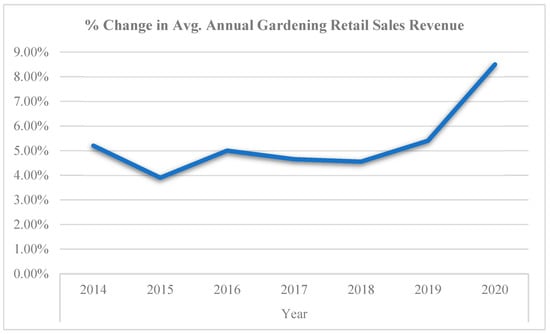
Figure 1.
Percentage Change in Gardening Retail Sales Revenue Between 2014 and 2020. Adapted from [6].
One of the popular plants among ‘plantitos’ or ‘plantitas’ are succulents [7]. Their global market size is growing, and the prospects of the succulent market are in an excellent state [8]. In 2020, the global succulent market was valued at USD 3.86 billion [9]. It is forecast to reach USD 8.24 billion by 2026, with the CAGR growing 16.89% from 2020 to 2027 [9].
Succulents have gained popularity in the market [10] as they come in many assorted colors, shapes, and sizes [11]. They are robust little plants and can thrive in any environmental conditions around the world, making them suitable to be kept indoors in urban living [7,12]. In addition, the increasing adoption of succulents due to their characteristic looks and distinctive appearances has benefited the market growth [10]. Other countries, such as America, have adopted cacti and other dwarf succulents as decorations on window boxes, miniature garden bowls, and other various designs [13].
Plantitas and plantitos have different preferences in buying succulents based on their different attributes. These attributes include the type of succulent family, price range, diameter size of the succulent, method of buying, the size of the pot, and the material of the pot. Succulent attributes are plantitas’ and plantitos’ preferred set of combinations when purchasing the plants. When someone is planning to buy a succulent, the type of plant, size in diameter, where they will buy (online or on-site), needs to be considered, as does the size and material of the pot in which the plant will grow. Hence, it is relevant to analyze these attributes, especially for the marketing strategy.
Understanding people’s purchase intentions is still one of the most important topics in any marketing study [14] for businesses to develop, improve, and advertise their products [15]. Conjoint analysis is a multivariate technique that has been used in consumer research since 1971 to identify the relative importance of each attribute that affects preference [16,17,18]. This technique has been the favorite of marketers to understand how each individual’s preference is developed [17]. Soutar and Turner [19] further emphasized that conjoint analysis can also investigate the importance of the attributes of the product/service and its impact on customers’ preferences [20]. This method uses an internet questionnaire to define consumers’ likings based on the different levels of attributes [21,22]. Then, the conjoint analysts will input the data into easy-to-use software simulators to foresee customers’ buying behaviors in choosing among the products [22].
For any business to build a good marketing strategy for their products, they need to understand their customer’s needs and develop customized market segmentation to gain an advantage against their competitors in providing the right services [23,24]. Of all the clustering methods, k-means clustering is the most well-used clustering method when segmenting a group of people with similar characteristics or according to their overall preferences [25,26]. It is also among the popular techniques used in marketing studies, as different panels of customers have a different fondness for a product’s features [27]. This method uses machine learning software such as SAS, SPSS, and MATLAB for traditional market analysis when the population of respondents is too large [28,29].
Previous studies on consumers’ preferences for different types of ornamental plants used the Conjoint Analysis approach. Townsley-Brascamp and Marr [30] conducted a study to identify the plant attributes that affect the consumers’ appreciation for ornamental plants using conjoint analysis. The results showed that ‘plant health’, ‘price’, ‘shape’, bushiness’, ‘color of the flower’, ‘the color of the leaf’, ‘final height’ and ‘sustainability for the consumer’s garden’ had a significant effect on the preference of consumers [30]. Similarly, Williams et al. [31] used conjoint analysis to assess consumers’ preference for the attributes of wild orchids in China by orchid owners and non-orchid owners. Of all the attributes, the price was the most important, followed by the flower color, among the respondents [31]. On top of that, the studies by Rihn et al. [32] and Behe et al. [33] used conjoint analysis and eye-tracking technology to investigate consumers’ purchase likelihood of ornamental plants and their visual attention. Both studies found that respondents’ visual attention to the aesthetics of plants had a strong positive effect on purchase likelihood [32,33]. They concluded that sellers and retailers should consider the visual display and the type of signage and information to include carefully as it impacts consumers’ preferences.
Furthermore, previous studies have also utilized conjoint analysis and k-means clustering on other families of plants. The objectives of the study by Behe et al. [34] determined the importance and consumers’ preference for flower color, leaf variegation, and price of geraniums using conjoint analysis. The k-means cluster, on the other hand, was used to find several market segments. The conjoint analysis results show that the color of the flower is the attribute that consumers consider before buying. Additionally, the k-means cluster yielded four actionable consumer segments. These are pink lovers, white lovers, red lovers, and lavender lovers. Likewise, Hugie et al. [35] used conjoint analysis to estimate consumers’ preference for turfgrasses based on maintenance attributes and k-means clustering to identify potential market segments. The outcome of the conjoint analysis revealed that the maintenance attribute ‘irrigation requirement’ has greatly affected people’s purchasing behavior [35]. The k-means clustering technique, on the other hand, identified four potential market segments: the Price Conscious segment, the Shade Adaptation segment, the Mowing Conscious segment, and the Water Conscious segment [35]. Each of the segments has distinct characteristics and values from each other.
With all the reviews of related works of literature discussed, surprisingly, there were no studies about plantitas’ and plantitos’ preferences for different families of succulents and the market segmentation using conjoint analysis and k-means clustering. Hence, it would be effective to use conjoint analysis to determine the preference of plantitas and plantitos for succulents and k-means clustering to identify the potential market segmentation.
This study aims to determine the various preferences of plantitas and plantitos based on succulent attributes using a conjoint analysis approach, and to discover the market segments using a k-means clustering approach. Specifically, this study utilized seven attributes with an orthogonal design to help evaluate the number of stimuli in the survey. The attributes were the type of succulent, variegation, price, size of the succulent, size of the pot, material of the pot, and payment method.
The analysis of this study can be used as a basis for future researchers for how conjoint analysis was integrated with k-means clustering to determine consumers’ preferences. Moreover, the results of this study can benefit retailers and sellers of succulents, as they will know their customers’ preferences and their target market, so they can strategize how they will sell their plants.
2. Methodology
Figure 2 shows the conceptual framework containing the attributes and levels adapted from Kulshreshtha et al. [36]. These are the seven succulent attributes with corresponding levels that may affect the decision-making of ‘plantitas’ and ‘plantitos’ when purchasing succulents, as shown in Table 1. These attributes and levels apply to those who have experience in taking care of succulents. In addition, the attributes and levels are in an orthogonality design, meaning that each level of an attribute appears equally across other attributes within the structure [37].
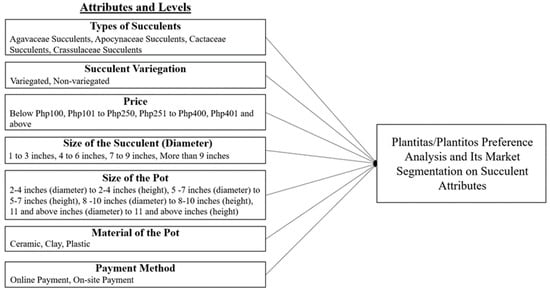
Figure 2.
The Conceptual Framework adapted from Kulshreshtha et al. [36].

Table 1.
Succulent Attributes and Levels.
For this process, the data gathering procedure was conducted by an online survey using Google Forms. The survey was distributed in the Philippines only. Once the researcher achieved the required number of respondents, they analyzed the survey results using two statistical tools, conjoint analysis and k-means cluster, using Python software.
The conjoint analysis determined the score of the relative importance of each attribute and the most preferred set of combinations of different succulent attributes [33]. The k-means, on the other hand, formed clusters or segments of ‘plantitas’ and ‘plantitos’ based on the frequency of buying behavior [38]. The analysis achieved this study’s expected output: to identify the attributes that ‘plantitas’ and ‘plantitos’ consider in buying, the most preferred combination set of attributes, and potential market segments.
2.1. Conceptual Framework and Research Design
Plantitas and plantitos have different preferences in buying succulents, based on the different levels of attributes. These attributes include the type of succulent family, price range, diameter size of the succulent, method of buying, the shape of the pot, and the type of the pot. Succulent attributes are plantitas’ and plantitos’ preferred set of combinations on purchasing the plants. An example is that when someone is planning to buy a succulent, the type of the plant, size in diameter, and where they will buy (online or on-site) needs to be considered, as well as the shape and type of the pot where the plant will grow. Hence, it is relevant to analyze the attributes, especially for the marketing strategy. Table 1 shows the different attributes and levels that may affect the preferences of plantitas and plantitos.
2.2. Selection of Attributes and Levels
The first attribute was the type of succulents. There are many common types of gardening, but indoor gardening is the most popular activity [39]. Among all the indoor plants, succulent plants are increasingly popular for collectors, home gardeners, and landscape designs for their colorful fleshy leaves, unique designs, ease of care, etc. [40]. For the types of succulents, four levels were considered: Agavaceae Succulent Family, Apocynaceae Succulents Family, Cactaceae Succulent Family, and Crassulaceae Succulent Family. These succulents are the four largest families of succulents, with over 1000+ species in each type [41,42,43,44]. These succulents are also sold in the Philippines. Their distinctions from each other are shown in Table 2.

Table 2.
Characteristics of the Types of Succulents.
The second was the variegation of the succulent. A variegated succulent means the plant possesses two or more different colors on its body surface. In the study by Lang et al. [57], they identified the preference of consumers for New Guinea Imfatiens based on the leaf variegation, the color of the flower, the price, and plant condition. Similarly, in the study by Behe et al. [34], they studied the consumers’ liking of geranium plants based on the leaf variegation, flower color, and price attributes. Both studies found that the plant’s variegation has the second-highest importance value among the attributes. In this attribute, two levels were considered: variegated and non-variegated. Each type of succulent has at least one species that is variegated.
The third attribute was the price. Aside from the plant quality, price is the second most important factor when purchasing a plant [58]. Price has a positive effect on purchase decision-making, especially for products usually bought, as it can influence the choice of store, product, and brand to buy [59]. The price range depends on the type of succulent and its size (diameter). For the price, four levels were listed: below PHP 100, PHP 101—PHP 250, PHP 251—PHP 400, PHP 401 and above. These levels are the usual prices of succulents in the Philippines.
Fourth, the size of ornamental plants was the most important factor in consumers’ preference in the study of Hardy et al. [60] and was also included in the study by Khachatryan and Choi [58]. Thus, it is included as an attribute in this study. Four levels were specified for the size of succulents (in terms of diameter): 1–3 inches, 4–6 inches, 7–9 inches, and more than 9 inches. Succulent retailers in the Philippines offer this range of sizes.
The fifth attribute was the size of the pot. The appropriate size of the pot depends on the size of the plant growing in it. A study by Poorter et al. [61] stated that doubling the pot size results in 43% more plant growth. For the size of the pot, four levels were considered: 2–4 inches (diameter) to 2–4 inches (height), 5–7 inches (diameter) to 5–7 inches (height), 8–10 inches (diameter) to 8–10 inches (height), and 11 and above inches (diameter) to 11 and above inches (height). These levels are available in plant retailers and online shopping platforms.
Sixth, the material of the pot was also one of the things to be considered when planting. Three levels were considered for the material pot: ceramic, clay, and plastic. Pots made from ceramic and clay are breathable pots for plants and allow proper water drainage and air circulation. Fiegel [62] added that plastic pots could also be an option, since they are lighter than ceramic and clay and are less likely to break. These are the common materials of pots used by gardeners in the Philippines.
The last attribute was the payment method. In buying succulents, two levels of payment modes were included: online and on-site. With the rise of the online market, many people buy different products online since they can be accessed worldwide 24/7 [63]. However, although many consumers began to switch to the online market due to the lockdown restrictions, some people still prefer to shop directly in the traditional market where they can see the product’s physical appearance [64].
2.3. Respondents of the Study
This study acquired at least 500 respondents (Table 3). The survey was conducted online by utilizing Google Forms. The online survey was distributed to individuals in the Philippines since ‘plantitas’ and ‘plantitos’ originated in the Philippines.

Table 3.
Demographics adapted from Ong et al. [15].
A 7-point Likert Scale was utilized in conducting the online survey. The respondents had the option to answer Strongly Dislike, Moderately Dislike, Slightly Dislike, Neutral, Slightly Prefer, Moderately Prefer, and Strongly Prefer, depending on their level of satisfaction with the combination of succulent attributes. In the journal of Joshi et al. [65], they emphasized that a 7-point Likert Scale provides more options for people, which increased the probability of meeting the study’s objective. The survey consisted of three parts: (1) Pictures and characteristics of the four types of succulents, (2) Demographics, and (3) A combination of succulent attributes.
2.4. Conjoint Analysis
This study used conjoint analysis to determine the importance of the attributes of succulents and their impact on plantitas’ and plantitos’ preferences, and used k-means clusters to identify the potential market segment. Conjoint analysis is a tool that marketers commonly use in marketing research to determine consumers’ preferences [14,17]. This method used an online survey using Google Forms to define consumers’ likings based on the different levels of attributes [21,22]. Then, the data collected were inputted into a conjoint analysis software to determine which attribute has the highest percentage of relative importance (RI). The attribute with the highest percent of RI means that it is the attribute that influences the purchasing behavior of ‘plantitas’ and ‘plantitos’ [22].
The conjoint analysis with an orthogonal design was generated by utilizing IBM SPSS Statistics v26. A total of 36 stimuli were generated (four holdouts included) by the SPSS to select the combination of succulent attributes and their levels (Table 4) [66].

Table 4.
Stimulus.
2.5. K-Means Cluster
On the other hand, k-means clustering is a helpful tool for data mining, compression, and segmentation [67]. This method uses machine learning software such as Python. An iterative process divides groups to produce a set of clusters (k) of the levels of the succulent attributes [68]. In performing k-means clustering, the average scores of each level must be identified first [69]. Hence, there are a set of 21 average values since there are 21 levels. Each level was put into a group with a random centroid that gives the minimum distance value of the average scores of all the levels and the average score of the centroid [69]. This process was repeated until no change happens in the members of each group and the centroid values. Then, the number of clusters (k) suitable for the discussion analysis was determined.
3. Results and Discussion
This study collected 854 respondents in 55 days of data gathering (Table 5). Among the genders, 52.9% of the respondents were female, 42% were male, and the remaining 5% answered ‘others’. In the age category, the largest population that answered the survey were the participants aged between 41 and 50 years old, with 32.7% of the total count. The smallest population was the participants aged below 20 years old, with only 7.4% of the total respondents. In the number of succulents owned, almost 47% of the participants answered that they had more than 16 succulents at home. Next, in the frequency of buying, more than half of the respondents, with 70.5% of the total population, answered that they only buy succulents once a month. Lastly, the majority of the respondents came from the NCR region, with 59.3%.

Table 5.
Demographics Profile.
Other information on the percentages (population count) of the demographics is shown in Table 5. For the data analysis, this study used conjoint analysis to determine the preference of plantitas and plantitos based on the attributes presented [14,17], and k-means cluster to group people with similar characteristics or according to their overall preference [25,26].
3.1. Conjoint Analysis Results
Table 6 shows the average importance scores of the seven succulent attributes. Based on the average scores, the price had the highest score with 34.985, followed by the size of the succulent (diameter) with (28.423), succulent variegation (13.947), size of the pot (10.834), method of payment (6.285), pot material (2.883), and type of succulents (2.643). Means, the price and the size of the succulents were the attributes that plant people consider before buying.

Table 6.
Importance Values.
Table 7 presents the utility scores of each attribute level. From the first attribute, type of succulents, most plantitas and plantitos preferred the Crassulaceae succulents to the three other types of succulents, since it had the highest score of 0.065. Next, consumers wanted variegated succulents more than non-variegated succulents for succulent variegation. Third, plantitas and plantitos preferred cheaper succulents, so succulents at the price of below PHP 100 had the highest utility score, followed by PHP 101 to PHP 250. In the fourth attribute, the succulent’s diameter size, consumers favored large size succulents with more than 9 inches diameter to medium or small size. Fifth, in accordance with the succulent size, consumers preferred the pot size with 11 and above inches (diameter) to 11 and above inches (height). Sixth, the ceramic pot was the most favored, followed by the plastic pot under the pot material attribute. Lastly, the seventh attribute was that consumers prefer buying succulents through online payment.

Table 7.
Utilities.
Table 8 shows the correlation of all the stimuli presented in this study. Pearson’s R correlation had a value of 0.973 and a significance test of 0.000. On the other hand, the correlation value of Kendall’s Tau was 0.863 with a significance test of 0.000. Since both correlation values of Pearson’s R and Kendall’s Tau were close to 1, this shows a significantly strong relationship between the observed and estimated preferences [15,17]. Moreover, this study uses four additional holdouts to give more consistency and measure reliability [70]. With that, the correlation value of Kendall’s Tau for holdouts was 1.000 with a significance of 0.021. This means that the data collected from the 854 respondents are valid.

Table 8.
Correlations.
3.2. Conjoint Analysis Discussion
To measure consumers’ preferences, this study utilized conjoint analysis [17]. Among the 36 stimuli, the conjoint analysis using the IBM SPSS Statistics v26 software revealed that plantitas and plantitos preferred the Crassulaceae succulents (UE = 0.065), variegated (UE = 0.295), below PHP 100 (UE = 0.816), more than 9 inches succulent diameter size (UE = 0.337), 11 × 11 pot size (UE = 0.179), ceramic pot (UE = 0.045), and online payment (0.133), with a total utility score of 1.870. On the other hand, the least preferred stimulus of plantitas and plantitos are the Apocynaceae succulents (UE = −0.047), non-variegated (UE = −0.295), PHP 401 and above (UE = −0.663), 1 to 3 inches succulent diameter size (UE = −0.864), 2–4 × 2–4 pot size (UE = −0.278), clay pot (UE = −0.077), and on-site payment (UE = −0.133), with a total utility score of –0.2357.
According to the Importance Values in Table 6, the price was the most important attribute considered by plantitas and plantitos with a score of 34.985%, followed by the diameter size of the succulent with a score of 28.423%. In contrast, the least essential attribute that plantitas and plantitas consider before buying was the type of succulents, with a score of 2.643%, followed by the pot material with a score of 2.883%. Therefore, succulent retailers should consider making their price reasonable, and ensuring the size of the succulent was within the preferred range when they sell them, rather than placing emphasis on the type of succulents and the kind of pot material they have.
Similarly, in the 2018 study by Williams et al. [31] on consumers’ preference for wild-collected ornamental orchids in China, the price was the most important attribute for the respondents. Among the levels, below PHP 100, which was the cheapest price, was the most preferred, and the most expensive price, which is PHP 401 and above, was the least preferred [15]. When customers buy goods or pay for services, price is one of the most concerning issues people consider before deciding [71]. This can also be applied when buying succulents or any plants. Aside from succulent retailers offering fair prices with high-quality products, a proposed marketing strategy that can help attract customers is to offer more succulents worth less than PHP 100, so that customers who are price conscious can still buy succulents at an affordable price.
The second most important attribute was the size of the succulent in terms of diameter. In the size category, the most preferred level was the largest size or more than 9 inches in diameter, and the least preferred was the smallest size of 1 to 3 inches in diameter. These findings were supported by the 2000 study of Hardy et al., where their results state that ‘plant size’ affects the purchasing intentions of the customers. Most consumers prefer large size plants over small ones because large size plants have higher growth rates and are more resistant to drought stress, according to Zots et al. [72]. Hence, large size plants are easier to maintain than small ones. A proposed marketing strategy for size is that succulent retailers could offer a promotion offering that when a customer exceeds a spending amount specified by the seller, they can buy a 9 inch (diameter) succulent at 50% off. This marketing plan will encourage customers to buy more succulents to receive a half-the-price discount on the large-size succulents.
Third, succulent variegation received a high importance value score next to price and size, with a score of 13.947. The results showed that respondents gave a higher rating when the succulent was variegated (more than one shade of color is present in the plant’s body) than when it was not variegated. In line with the results from the study by Kaufman and Lohr [73], people exhibit strong responses to a range of plant/tree colors, specifically red, orange, green, and yellow. These findings are caused by the emotional and physiological factors that different colors of nature attract people’s attention faster.
Next, the size of the pot was the fourth attribute with the highest importance score of 10.834. Among the pot sizes presented in this study, the 11 × 11 pot size had the highest utility score of 0.179. This result was aligned with the results from the size of the succulent, where the most preferred was the biggest size or more than 9 inches in diameter. According to Poorter et al. [61], the plant should have enough space to encourage more root growth and plant size growth. Their study discovered that doubling the pot size results in 43% more plant growth.
The payment method was the first attribute that belongs to the attributes that receive a low rating. The payment method only has an importance score of 6.285. Due to the high number of COVID-19 cases during the time of data gathering, the majority of the respondents prefer to buy and carry out their transactions online rather than on-site. In relation to the article of Gu et al. [74] and Nawaz and Alajmi [63], online buying and selling underwent a boom during the pandemic lockdown since people are avoiding close interaction with others. In addition, people are now shifting to online buying and selling since it is accessible worldwide 24/7. However, some still prefer to buy in traditional markets [64].
Second, the attribute that plantitas and plantitos preferred the least was the pot material. The respondents favored pots made from ceramic, followed by plastic pots and clay pots. Ceramic pots are usually made from finely textured, light-colored clay and glazed to look like glass [75]. These materials allow proper air circulation and water movement to help the plant’s root growth, making the plant healthier [76]. On the other hand, plastic and clay pots are also suitable for succulents. However, the disadvantage of these two is that plastic pots do not allow airflow, which holds moisture longer, and clay pots are the heaviest materials and the least durable [76]. Therefore, ceramic is the best pot material for plants, but it contradicts the results from the price. According to Coblentz [77], ceramic pots cost more than other pot materials because of the material used and the labor cost. The usual starting price of ceramic pots is USD 10, which is about PHP 521.56 when converted.
Lastly, as mentioned in the previous paragraphs, the least significant attribute for plantitas and plantitos was the type of succulent. Out of the four levels, the Crassulaceae succulents had the highest utility estimates, and the Apocynaceae succulents had the lowest score. This result contrasts with the results of Behe et al. [78]. Their study found that most of their participants selected the ‘plant type’ as the attribute that affects their purchase intentions [78].
3.3. K-Means Cluster Results
Represented in Figure 3 is the elbow method utilized to determine the number of clusters that could be created with the least possible sum-of-squared error (SSE) error. Different clusters of three, four, and five were tested, and the best SSE result was with three clusters: the lower the SSE, the better the clustering with the optimal algorithm [79]. The k-means clusters are presented in Figure 4.
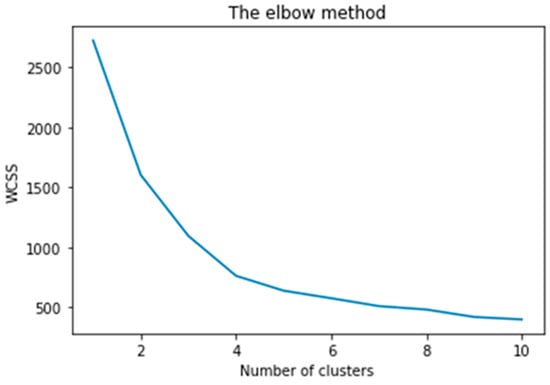
Figure 3.
Elbow Method.
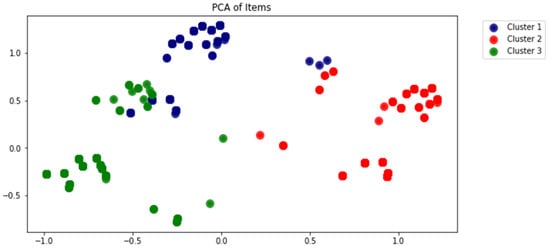
Figure 4.
K-Means Clustering.
The different classes by the frequency of buying behavior in terms of age, gender, and number of owned succulents were considered in this research to create market segments. These segments were utilized to create different marketing strategies that are customer-focused. Hence, market segments based on the respondents’ preference for the attributes were not considered for this study as it will limit the marketing strategies to the preference itself only.
As seen in Figure 5, the largest number of succulents owned were bought with class 2 (twice a week), followed by class 1 (once a week), class 3 (thrice a week), and low frequency among buyers with class 4 (buys once a month). Consequently, the age of frequent buyers was considered, as seen in Figure 6. Based on the results, bulk buyers are 20–50 years old. Linking the results to the number of succulents owned, the majority of the frequent buyers were 31 to 40 years old, followed by 41 to 50 years old and 20 to 30 years old. Low frequency buyers were below 20 years old and above 51 years old.
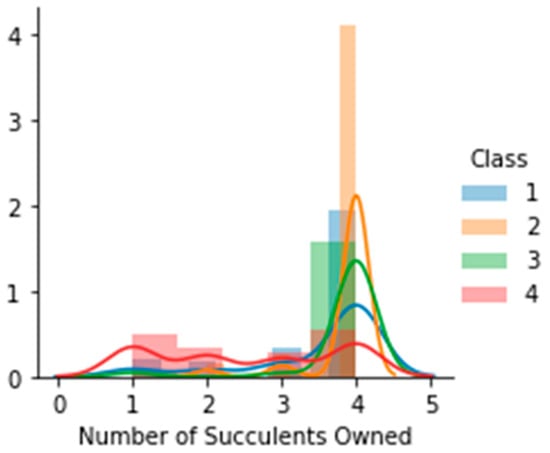
Figure 5.
Number of Succulents Owned.
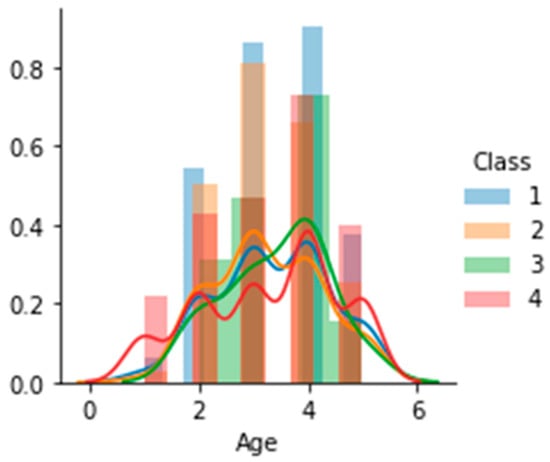
Figure 6.
Age.
Lastly, genders were considered as represented by Figure 7. Based on the results, the majority of the frequent buyers were female, followed by male buyers. Female buyers had a high tendency of buying at least one succulent per month between 41 and 50 years old, and it could be seen that frequent buyers (once or twice a week) were female between 20 and 40 years old. On the other hand, frequent male buyers were 20–30 years old, while male buyers 41 years old and older were not frequent buyers. Thus, the target market should be among the lower-aged groups.
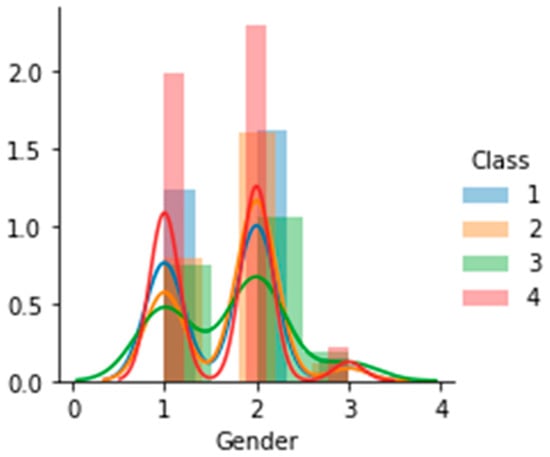
Figure 7.
Gender.
Presented in Figure 8 is the graphical segmentation based on gender, age, and owned succulents for the frequency of buying. It could be inferred that high-value customers were both male and female, buying succulents at least twice a week, and were between 20 and 40 years old. The core customers were female buyers who buy succulents at least once or twice a week and are between 31 and 50 years old. Lastly, the lower-value customers of both genders buy thrice a week or once a month and are between 31 and 50 years old.
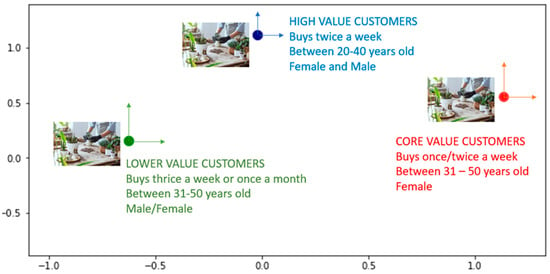
Figure 8.
Graphical Segmentation.
3.4. K-Means Cluster Discussion
In this paper, all clustering computations were performed using Python Software [80]. The k-means cluster algorithm was utilized to group the different types of customers according to the frequency of buying behavior in terms of their age, gender, and the number of succulents they have. A three-cluster solution was selected based on the results from the elbow method (Figure 3) and the graphical segmentation (Figure 8). Therefore, there were three different types of buying behavior related to providers [81]. Table 9 shows the types of customer value, the description for each, and the proposed value-adding services that succulent sellers can offer. In addition, the marketing strategies for the conjoint analysis results can also be applied to the three types of customers. As for the price, sellers should also offer cheap price succulents, preferably PHP 100 and below, since respondents gave a high rating to a stimulus with this level. For the size, on the other hand, high-value, core-value, and lower-value customers could still buy the large-size succulent with a discount if they exceed the minimum amount set by the seller.

Table 9.
Marketing Strategies for Different Customer Segments.
The first cluster segment is called High-Value Customers. These customers are both male and female, between 20 and 40 years old, and are willing to spend more than PHP 200 for every purchase. They are labeled as high-value customers since they buy succulents twice a week and they are considered the golden assets of an enterprise as they can bring more profit [82]. The proposed value-adding services for these customers are shown in the High-value Customers’ row in Table 8. There will be two free small potted succulents (variegated) and a re-potting service for any size of succulents they bought, so customers will not have to re-pot the succulents on their own since re-potting is a time-consuming activity. Additionally, high-value customers will receive news and updates on what succulents will be released in the following days. This will enable them to be first-in-line buyers and reserve their choices for a maximum of 1 week. Lastly, succulent retailers can also offer free shipping since this can increase retailers’ sales in the short run [83] and in the long run [84].
The second cluster segment is called Core-Value Customers. These customers are only females aged between 31 and 50 years old who buy succulents once or twice a week and are willing to spend between PHP 150 and PHP 350 every time they buy. The proposed marketing strategy is shown in the Core-Value Customers’ row in Table 8. There will also be a free small potted succulent (variegated or non-variegated) and a re-potting service for them, but only for the small-size succulents since they are more delicate to re-pot considering the maturity of their roots. Additionally, upon the release of succulents, core-value customers can choose any plant of their choice that is still available and have it reserved for them for a maximum of 1 week. Lastly, succulent retailers can also offer a free shipping service if the customer spends more than the specified amount set by the seller, as this positively influences the customer’s mood and interest in buying more products [85].
The third cluster segment is called Lower-Value Customers. These customers are both male and female and aged between 31 and 50 years old, and are willing to spend less money or PHP 150 and below every purchase. They are labeled as lower-value customers because their buying behavior is the same or less than the frequency of buying or regular customers. The proposed value-adding services are also shown in the Lower-Value Customers’ row in Table 8. For a business to maintain its competency, they must develop new offerings for all types of customers to create a positive effect on customer retention [86]. Additionally, by giving their regular customers a free unpotted small-size succulent (non-variegated), if the total amount exceeds the minimum value, they will encourage customers to buy more plants and more frequently, since most succulent retailers do not offer any freebies to their lower-value customers. Lastly, retailers can offer them free gardening materials, especially for new plantitas and plantitos, to encourage them to love planting more.
Adding a shipping threshold to determine the total amount for the free shipping service can benefit the business by protecting its profit margins [87]. Kluz [88] added that it is a marketing tool used to encourage customers to spend more money by having a free shipping service. In computing the threshold, the formula is shown in Figure 9 below:

Figure 9.
Shipping Threshold Formula.
Subtract the Minimum Cart Value (MCV), which the seller sets (e.g., PHP 500) from the Average Order Value (AOV), which is the average PHP amount that customers spent on each order. Then, the result should be multiplied by the Gross Profit Margin (GPM), which is computed by subtracting the revenue and the cost of goods sold. Finally, the Average Shipping Costs should be subtracted from the result. Once all computations were complete, the value should be greater than 0 for the free shipping threshold to be viable. Otherwise, it will not be fiscally possible, and the seller would lose profit.
4. Conclusions
Many people have switched to gardening as their new hobby during the COVID-19 pandemic [89,90,91,92,93,94,95,96,97,98], including Filipinos. The main objective of this study was to determine the preference of plantitas and plantitos for the succulent attributes presented and to perform cluster segments based on the similarities of their answers. This study integrated two statistical analysis tools, conjoint analysis and k-means clustering analysis, to help succulent retailers develop and improve their marketing strategy to gain more potential customers and profit [23,99,100]. A total of 854 respondents answered the survey, consisting of the demographics, characteristics of each succulent type, and the 36 stimuli, including the four holdouts. The survey lasted for 55 days.
The conjoint analysis results revealed that, out of all the attributes in this study, plantitas and plantitos take into consideration the price of succulents followed by the size of the succulent before they buy. The results indicated that plantitas and plantitos preferred succulents below PHP 100 and with a diameter size of more than 9 inches. On the other hand, based on the clustering analysis, the results were able to find out that there were three types of customers based on their buying behavior. These were the high-value customers, core-value customers, and lower-value customers. These customers were distinct from one another and need different marketing strategies that succulent retailers can use to attract and maintain their customers. However, the marketing strategy based on the conjoint analysis results can apply to all types of customers as it is a promotion and not a value-adding service.
The analysis of this study will be very useful for future researchers interested in taking up plant-related topics for their research since this is the first, complete study that analyzes the plantitas’ and plantitos’ preferences for succulent attributes and the market segmentation. The discussion can also help succulent sellers/retailers gain insights into how to develop a marketing strategy that will move their business ahead of others.
Limitations and Future Research Direction
Despite its significant and substantial contributions, the authors would like to acknowledge several limitations of this study. First, this study was limited to only four different types of succulent: Agavaceae succulents, Apocynaceae succulents, Cactaceae succulents, and Crassulaceae succulents. In fact, there are more types of succulent. Future researchers can extend this study to other plant types. Second, the approach of this study was more focused on quantitative analysis. A combination of quantitative and qualitative analyses could enhance the depth of analysis particularly related to gardening preferences. Additionally, future researchers can add more specifications (e.g., average budget to spend and preference for each attribute’s levels) to the characteristics of each type of customer that is generated in the k-means results. Lastly, future academics can add marketing strategies in the conjoint analysis discussion on each attribute and more value-adding services on the k-means discussion to encourage more customers to buy all of the seller’s products.
Author Contributions
Conceptualization, A.K.S.O., Y.T.P. and L.A.S.D.L.; methodology, A.K.S.O., Y.T.P. and L.A.S.D.L.; software, A.K.S.O., Y.T.P. and L.A.S.D.L.; validation, I.D.A., R.N. and S.F.P.; formal analysis, A.K.S.O., Y.T.P. and L.A.S.D.L.; investigation, A.K.S.O., Y.T.P. and L.A.S.D.L.; resources, L.A.S.D.L.; writing—original draft preparation, A.K.S.O., Y.T.P. and L.A.S.D.L.; writing—review and editing, I.D.A., R.N. and S.F.P.; supervision, Y.T.P., S.F.P. and R.N.; funding acquisition, Y.T.P. All authors have read and agreed to the published version of the manuscript.
Funding
This research was funded by Mapúa University Directed Research for Innovation and Value Enhancement (DRIVE).
Institutional Review Board Statement
This study was approved by Mapua University Research Ethics Committees (FM-RC-22–41).
Informed Consent Statement
Informed consent was obtained from all subjects involved in the study (FM-RC-22–41).
Data Availability Statement
The data presented in this study are available on request from the corresponding author.
Acknowledgments
The researchers would like to extend their deepest gratitude to the respondents of this study despite the current COVID-19 inflation rate.
Conflicts of Interest
The authors declare no conflict of interest.
Appendix A

| Attributes | Levels |
|---|---|
| Types of Succulents | 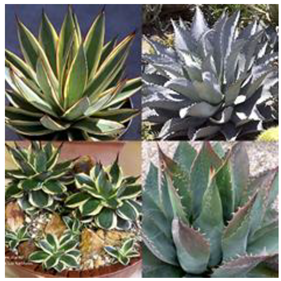 Agavaceae Succulents 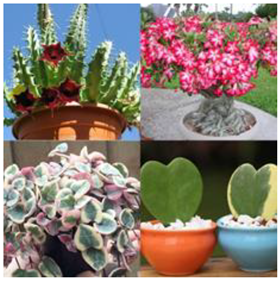 Apocynaceae Succulents 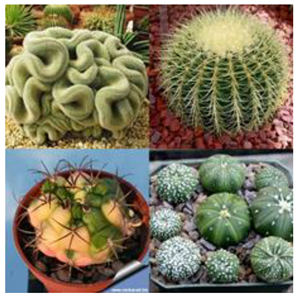 Cactaceae Succulents 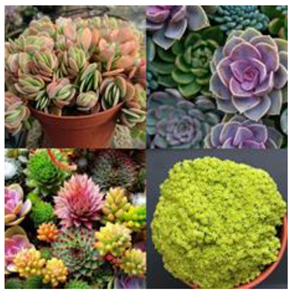 Crassulaceae Succulents |
References
- Schmutz, U.; Turner, M.L.; Williams, S.; Devereaux, M.; Davies, G. The Benefits of Gardening and Food Growing for Health and Wellbeing; Garden Organic and Sustain: Ting Kok, Hong Kong, 2014. [Google Scholar]
- del Monte, P. How “Plant Parenting” Can Aid in Coping Amid the Pandemic; CNN Philippines: Mandaluyong, Philippines, 2020. [Google Scholar]
- Perez, J.A. Gardening for Peace of Mind during the COVID-19 Crisis. Acad. Lasalliana J. Educ. Humanit. 2013, 2. [Google Scholar] [CrossRef]
- Beleo, E. Demand for flowerpots on a surge amid COVID-19 lockdowns. Manila Bulletin, 29 July 2020. [Google Scholar]
- Dave. Millennial Households Continue to Provide Optimism for the Lawn and Garden Industry. Available online: https://garden.org/newswire/view/dave/22/Millennial-Households-Continue-to-Provide-Optimism-for-the-Lawn-and-Garden-Industry/ (accessed on 16 September 2022).
- Coppess, A. THE RISE IN GARDENING RETAIL DURING COVID-19. Available online: https://www.brecks.com/blog/covid-gardening-retail-boom (accessed on 16 June 2022).
- Marcos, A. The rise of Plantitas and Plantitos. Daily Tribune, 2020. [Google Scholar]
- Succulent Plant Market Size and Share, Scope, Trends and Forecast; Verified Market Research: Pune, India, 2019.
- Succulent Plant Market 2021 is estimated to clock a modest CAGR of 17.9%Â during the forecast period 2021–2026 with Top Countries Data. 2News, 2021.
- Succulent Plant Market Size, Trends & Analysis, By Type, By Products (Single Head, Bulls, Fascicular, Old Pile, Combination), By Application (Household, Commercial, Others), By Region- Global Forecast To 2027; Reports and Data. Available online: https://www.reportsanddata.com/report-detail/succulent-plant-market (accessed on 16 September 2022).
- Daigle, T. DIY Succulents: From Placecards to Wreaths, 35+ Ideas for Creative Projects with Succulents; Simon and Schuster: New York, NY, USA, 2015. [Google Scholar]
- Cabahug, R.A.M.; Nam, S.Y.; Lim, K.B.; Jeon, J.K.; Hwang, Y.J. Propagation Techniques for Ornamental Succulents. Flower Res. J. 2018, 26, 90–101. [Google Scholar] [CrossRef]
- Books, A.P. Dwarf Succulents. Nature 1932, 130, 613–614. [Google Scholar] [CrossRef]
- Eggers, F.; Sattler, H. Preference Measurement with Conjoint Analysis: Overview of State-of-the-Art Approaches and Recent Developments. GfK Keting Intell. Rev. 2011, 3, 36–47. [Google Scholar] [CrossRef]
- Ong, A.K.S.; Prasetyo, Y.T.; Libiran, M.A.D.C.; Lontoc, Y.M.A.; Lunaria, J.A.V.; Manalo, A.M.; Miraja, B.A.; Young, M.N.; Chuenyindee, T.; Persada, S.F.; et al. Consumer Preference Analysis on Attributes of Milk Tea: A Conjoint Analysis Approach. Foods 2021, 10, 1382. [Google Scholar] [CrossRef]
- Green, P.E.; Srinivasan, V. Conjoint Analysis in Consumer Research: Issues and Outlook. J. Consum. Res. 1978, 5, 103. [Google Scholar] [CrossRef]
- Prasetyo, Y.T.; Suzianti, A.; Dewi, A.P. Consumer preference analysis on flute attributes in Indonesia using conjoint analysis. In Proceedings of the International Conference on Advanced Design Research and Education 2014 ICADRE14, Singapore, 16–18 July 2014 2014. [Google Scholar]
- Veitch, J.; Salmon, J.; Deforche, B.; Ghekiere, A.; Van Cauwenberg, J.; Bangay, S.; Timperio, A. Park attributes that encourage park visitation among adolescents: A conjoint analysis. Landsc. Urban Plan. 2017, 161, 52–58. [Google Scholar] [CrossRef]
- Soutar, G.N.; Turner, J.P. Students’ preferences for university: A conjoint analysis. Int. J. Educ. Manag. 2002, 16, 40–45. [Google Scholar] [CrossRef]
- Cattin, P.; Wittink, D.R. Commercial Use of Conjoint Analysis: A Survey. J. Mark. 1982, 46, 44. [Google Scholar] [CrossRef]
- Ariji, M. Conjoint analysis of consumer preference for bluefin tuna. Fish. Sci. 2010, 76, 1023–1028. [Google Scholar] [CrossRef]
- Green, P.E.; Krieger, A.M.; Wind, Y. Thirty Years of Conjoint Analysis: Reflections and Prospects. Interfaces 2001, 31, S56–S73. [Google Scholar] [CrossRef]
- Pascal, C.; Ozuomba, S.; Kalu, C. Application of K-Means Algorithm for Efficient Customer Segmentation: A Strategy for Targeted Customer Services. Int. J. Adv. Res. Artif. Intell. 2015, 4. [Google Scholar] [CrossRef][Green Version]
- Chiciudean, G.; Chiciudean, D. Customer Segmentation by Attributes Considered Important During the Buying Decision-Making Process for Cheese. Bull. UASVM Hortic. 2013, 70, 287–292. [Google Scholar]
- Kodinariya, T.M.; Makwana, P.R. Review on determining number of Cluster in K-Means Clustering. Int. J. 2013, 1, 90–95. [Google Scholar]
- Vigneau, E.; Qannari, E.; Navez, B.; Cottet, V. Segmentation of consumers in preference studies while setting aside atypical or irrelevant consumers. Food Qual. Prefer. 2016, 47, 54–63. [Google Scholar] [CrossRef]
- Hemalatha, M.; Sivakumar, V.; Jayakumar, G.D.S. Segmentation of Indian shoppers based on store attributes. Int. J. Bus. Innov. Res. 2009, 3, 651. [Google Scholar] [CrossRef]
- Ghosh, S.; Kumar, S. Comparative Analysis of K-Means and Fuzzy C-Means Algorithms. Int. J. Adv. Comput. Sci. Appl. 2013, 4. [Google Scholar] [CrossRef]
- Momeni, M.; Mohseni, M.; Soofi, M. Clustering Stock Market Companies via K-Means Algorithm. Kuwait Chapter Arab. J. Bus. Manag. Rev. 2015, 4, 1–10. [Google Scholar] [CrossRef][Green Version]
- Townsley-Brascamp, W.; Marr, N. Evaluation and Analysis of Consumer Preferences for Outdoor Ornamental Plants. Acta Hortic. 1995, 391, 199–208. [Google Scholar] [CrossRef]
- Williams, S.J.; Gale, S.W.; Hinsley, A.; Gao, J.; St. John, F.A.V. Using consumer preferences to characterize the trade of wild-collected ornamental orchids in China. Conserv. Lett. 2018, 11, e12569. [Google Scholar] [CrossRef]
- Rihn, A.; Khachatryan, H.; Campbell, B.; Hall, C.; Behe, B. Consumer preferences for organic production methods and origin promotions on ornamental plants: Evidence from eye-tracking experiments. Agric. Econ. 2016, 47, 599–608. [Google Scholar] [CrossRef]
- Behe, B.K.; Campbell, B.L.; Khachatryan, H.; Hall, C.R.; Dennis, J.H.; Huddleston, P.T.; Fernandez, R.T. Incorporating Eye Tracking Technology and Conjoint Analysis to Better Understand the Green Industry Consumer. HortScience 2014, 49, 1550–1557. [Google Scholar] [CrossRef]
- Behe, B.; Nelson, R.; Barton, S.; Hall, C.; Safley, C.D.; Turner, S. Consumer Preferences for Geranium Flower Color, Leaf Variegation, and Price. HortScience 1999, 34, 740–742. [Google Scholar] [CrossRef]
- Hugie, K.; Yue, C.; Watkins, E. Consumer Preferences for Low-input Turfgrasses: A Conjoint Analysis. HortScience 2012, 47, 1096–1101. [Google Scholar] [CrossRef]
- Kulshreshtha, K.; Bajpai, N.; Tripathi, V. Consumer preference for electronic consumer durable goods in India: A conjoint analysis approach. Int. J. Bus. Forecast. Mark. Intell. 2017, 3, 13. [Google Scholar] [CrossRef]
- Chrzan, K. Three kinds of order effects in choice-based conjoint analysis. Mark. Lett. 1994, 5, 165–172. [Google Scholar] [CrossRef]
- Green, P.E.; Helsen, K. Cross-Validation Assessment of Alternatives to Individual-Level Conjoint Analysis: A Case Study. J. Mark. Res. 1989, 26, 346. [Google Scholar] [CrossRef]
- Axiom Marketing. Gardening Insight Survey: Gardening in a COVID-19 World. (2020, November); Axiom: Minneapolis, MN, USA, 2021. [Google Scholar]
- Patel, R.M.; Qureshimatva, U.M.; Maurya, R.R.; Solanki, H.A. A checklist of succulent plants of Ahmedabad, Gujarat, India. Trop. Plant Res. 2016, 3, 686–693. [Google Scholar] [CrossRef]
- Bakr, R.O. A Comprehensive Review of the Aizoaceae Family: Phytochemical and Biological Studies. Nat. Prod. J. 2021, 11, 288–304. [Google Scholar] [CrossRef]
- Dickinson, R.; Royer, F. Weeds of North America. Nativ. Plants J. 2015, 16, 72. [Google Scholar] [CrossRef]
- Zimmermann, H.G.; Moran, V.C.; Hoffmann, J.H. Biological control of tropical weeds using arthropods (Rangaswami Muniappan ed.); Cambridge University Press: Cambridge, UK, 2009. [Google Scholar]
- Xu, Z.; Deng, M. Crassulaceae. In Identification and Control of Common Weeds: Volume 2; Springer: Berlin/Heidelberg, Germany, 2017; pp. 475–486. [Google Scholar]
- Arizaga, S.; Ezcurra, E. Propagation mechanisms in agave macroacantha (Agavaceae), a tropical arid-land succulent rosette. Am. J. Bot. 2002, 89, 632–641. [Google Scholar] [CrossRef] [PubMed]
- Eggli, U.; Arroyo-Leuenberger, S.; Bayer, M.B.; Bogner, J.; Eggli, U.; Forster, P.I.; Hunt, D.R.; Jaarsveld, E.J.; Meyer, N.L.; Newton, L.; et al. Illustrated Handbook of Succulent Plants: Monocotyledons; Springer: Berlin/Heidelberg, Germany, 2013. [Google Scholar]
- Iannotti, M.; Leverette, M.M. How to Grow and Care for Agave; The Spruce: New York, NY, USA, 2021. [Google Scholar]
- Hodgkiss, R.J. Apocynaceae. The Succulent Plant Page, 2 August 2021. [Google Scholar]
- Foster, N. How To Care For A Hoya Houseplant; Joy Us Garden: Santa Barbara, CA, USA, 2021. [Google Scholar]
- Groen, A.H. Apocynum androsaemifolium: Introductory; Fire Effects Information System (FEIS): Fort Collins, CO, USA, 2005. [Google Scholar]
- What Is a Cactus? Macmillan Dictionary Blog. Available online: https://www.macmillandictionaryblog.com/cactus (accessed on 16 September 2022).
- West Coast Gardens. 5 Care Tips to Keep Your Cactus Happy—Tips. West Coast Gardens, 15 April 2021. [Google Scholar]
- Cactus Light Requirements—How Much Light do Cacti Need? Plant Index, 17 June 2022.
- Grant, B.L. Stonecrop Plant—Planting Stonecrop in Your Garden; Gardening Know How: Bedford, OH, USA, 2021. [Google Scholar]
- Miller, R. All You Need to Know About Stonecrop Succulents; Succulent City: Chicago, IL, USA, 2021. [Google Scholar]
- Carey, D. Top Tips for Growing Sedum Stonecrop the Right Way; Plant Delights Nursery: Raleigh, NC, USA, 2016. [Google Scholar]
- Lang, H.J.; Agnew, N.H.; Behe, B.K. Consumer Preference for Leaf Variegation, Flower Color, Price and Use of New Guinea Imfatiens. HortScience 1992, 27, 606c. [Google Scholar] [CrossRef]
- Khachatryan, H.; Choi, H.J. Factors Affecting Consumer Preferences and Demand for Ornamental Plants; UF/IFAS Extension: Gainesville, FL, USA, 2014. [Google Scholar]
- Faith, D.O.; Agwu, M.E. A Review of the Effect of Pricing Strategies on the Purchase of Consumer Goods. Res. Manag. Sci. Technol. 2019, 2. [Google Scholar] [CrossRef]
- Hardy, J.; Behe, B.K.; Barton, S.S.; Page, T.J.; Schutzki, R.E.; Muzii, K.; Fernandez, R.T.; Haque, M.T.; Brooker, J.; Hall, C.R.; et al. Consumers Preferences for Plant Size, Type of Plant Material and Design Sophistication in Residential Landscaping. J. Environ. Hortic. 2000, 18, 224–230. [Google Scholar] [CrossRef]
- Poorter, H.; Bühler, J.; van Dusschoten, D.; Climent, J.; Postma, J.A. Pot size matters: A meta-analysis of the effects of rooting volume on plant growth. Funct. Plant Biol. 2012, 39, 839. [Google Scholar] [CrossRef]
- Fiegel, J. The 13 Best Pots for Indoor Plants in 2021. Bustle, 20 May 2021. [Google Scholar]
- Nawaz, N.; Alajmi, W.Y.A. A Study on Consumer Preferences for E Shopping with Reference to Bahraini Consumers. SSRN Electron. J. 2014. [Google Scholar] [CrossRef]
- Shanthi, R.; Desti, K. Consumers’ perception on online shopping. J. Mark. Consum. Res. 2015, 13, 14–21. [Google Scholar]
- Joshi, A.; Kale, S.; Chandel, S.; Pal, D. Likert Scale: Explored and Explained. Br. J. Appl. Sci. Technol. 2015, 7, 396–403. [Google Scholar] [CrossRef]
- Ong, A.K.S.; Prasetyo, Y.T.; Young, M.N.; Diaz, J.F.T.; Chuenyindee, T.; Kusonwattana, P.; Yuduang, N.; Nadlifatin, R.; Redi, A.A.N.P. Students’ Preference Analysis on Online Learning Attributes in Industrial Engineering Education during the COVID-19 Pandemic: A Conjoint Analysis Approach for Sustainable Industrial Engineers. Sustainability 2021, 13, 8339. [Google Scholar] [CrossRef]
- Hamerly, G.; Elkan, C. Learning the k in K-means. Adv. Neural Inf. Process. Syst. 2003, 16, 281–288. [Google Scholar]
- Kurniawan, C.; Setyosari, P.; Kamdi, W.; Ulfa, S. Electrical engineering student learning preferences modelled using k-means clustering. Glob. J. Eng. Educ. 2018, 20, 140–145. [Google Scholar]
- Ariff, N.M.; Bakar, M.A.; Zamzuri, Z.H. Academic preference based on students’ personality analysis through k-means clustering. Malays. J. Fundam. Appl. Sci. 2020, 16, 328–333. [Google Scholar] [CrossRef]
- Orme, B.K.; King, W.C. Conducting Full-Profile Conjoint Analysis over the Internet. Quirk’s Media, 1 July 1998. [Google Scholar]
- Ha, V.D. Determinants of Milk Tea Selection In Ho Chi Minh City. Multidiscip. Res. Dev. 2020, 2, 23–28. [Google Scholar]
- Zotz, G.; Hietz, P.; Schmidt, G. Small plants, large plants: The importance of plant size for the physiological ecology of vascular epiphytes. J. Exp. Bot. 2001, 52, 2051–2056. [Google Scholar] [CrossRef]
- Kaufman, A.; Lohr, V. Does Plant Color Affect Emotional and Physiological Responses to Landscapes? Acta Hortic. 2004, 639, 229–233. [Google Scholar] [CrossRef]
- Gu, S.; ŚLusarczyk, B.; Hajizada, S.; Kovalyova, I.; Sakhbieva, A. Impact of the COVID-19 Pandemic on Online Consumer Purchasing Behavior. J. Theor. Appl. Electron. Commer. Res. 2021, 16, 2263–2281. [Google Scholar] [CrossRef]
- Jaques, L. Plant Containers, Pots, and Planters—What Material Is the Best? Gardener’s Path, 7 September 2014. [Google Scholar]
- Baker, M. Do Houseplants Live Longer in Plastic or Ceramic Pots? HomeGuides SF Gate, 25 November 2019. [Google Scholar]
- Coblentz, J. Why Are Plant Pots So Expensive? (Find Out Now!). Upgraded Home. 2021. Available online: https://upgradedhome.com/why-are-plant-pots-so-expensive/ (accessed on 16 September 2022).
- Behe, B.K.; Campbell, B.L.; Hall, C.R.; Khachatryan, H.; Dennis, J.H.; Yue, C. Consumer Preferences for Local and Sustainable Plant Production Characteristics. HortScience 2013, 48, 200–208. [Google Scholar] [CrossRef]
- Fränti, P.; Sieranoja, S. How much can K-means be improved by using better initialization and repeats? Pattern Recognit. 2019, 93, 95–112. [Google Scholar] [CrossRef]
- Battaglia, O.R.; Di Paola, B.; Fazio, C. K-means Clustering to Study How Student Reasoning Lines Can Be Modified by a Learning Activity Based on Feynman’s Unifying Approach. EURASIA J. Math. Sci. Technol. Educ. 2017, 13, 6. [Google Scholar] [CrossRef]
- Prasetyo, Y.T. Consumer Preference Analysis on Mobile Service Providers: A Case Study of Foreign Students in Taiwan. In Proceedings of the 2019 IEEE 6th International Conference on Engineering Technologies and Applied Sciences (ICETAS 2019), Kuala Lumpur, Malaysia, 20–21 December 2019. [Google Scholar] [CrossRef]
- Zhao, M.; Zeng, Q.; Chang, M.; Tong, Q.; Su, J. A Prediction Model of Customer Churn considering Customer Value: An Empirical Research of Telecom Industry in China. Discret. Dyn. Nat. Soc. 2021, 2021, 1–12. [Google Scholar] [CrossRef]
- Lewis, M.; Singh, V.; Fay, S. An Empirical Study of the Impact of Nonlinear Shipping and Handling Fees on Purchase Incidence and Expenditure Decisions. Mark. Sci. 2006, 25, 51–64. [Google Scholar] [CrossRef]
- Bower, A.B.; Maxham, J.G. Return Shipping Policies of Online Retailers: Normative Assumptions and the Long-Term Consequences of Fee and Free Returns. J. Mark. 2012, 76, 110–124. [Google Scholar] [CrossRef]
- Huang, W.H.; Shen, G.C.; Liang, C.L. The effect of threshold free shipping policies on online shoppers’ willingness to pay for shipping. J. Retail. Consum. Serv. 2019, 48, 105–112. [Google Scholar] [CrossRef]
- Rahman, S.R.; Fardous, J. Effects of Value-Added Service on Customer Retention: “A case study on Telenor Bangladesh”. Master’s Thesis, Independent Thesis. 2020. Available online: http://www.diva-portal.org/smash/record.jsf?pid=diva2%3A1591538&dswid=1931 (accessed on 16 September 2022).
- Owens, B. How to set your free shipping threshold. Whiplash, 30 September 2021. [Google Scholar]
- Kluz, L. How to Offer Free Shipping & How to Calculate Your Free Shipping Threshold. A Better Lemonade Stand, 2 July 2018. [Google Scholar]
- Wu, C.-F.; Chou, L.-W.; Huang, H.-C.; Tu, H.-M. Perceived COVID-19-related stress drives home gardening intentions and improves human health in Taiwan. Urban For. Urban Green. 2022, 78, 127770. [Google Scholar] [CrossRef] [PubMed]
- Ambrose, G.; Das, K.; Fan, Y.; Ramaswami, A. Comparing happiness associated with household and community gardening: Implications for Food Action Planning. Landsc. Urban Plan. 2023, 230, 104593. [Google Scholar] [CrossRef]
- Song, S.; Cheong, J.C.; Lee, J.S.H.; Tan, J.K.N.; Chiam, Z.; Arora, S.; Png, K.J.Q.; Seow, J.W.C.; Leong, F.W.S.; Palliwal, A.; et al. Home Gardening in Singapore: A feasibility study on the utilization of the vertical space of retrofitted high-rise public housing apartment buildings to increase urban vegetable self-sufficiency. Urban For. Urban Green. 2022, 78, 127755. [Google Scholar] [CrossRef]
- Kingsley, J.; Diekmann, L.; Egerer, M.H.; Lin, B.B.; Ossola, A.; Marsh, P. Experiences of gardening during the early stages of the COVID-19 pandemic. Health Place 2022, 76, 102854. [Google Scholar] [CrossRef]
- McGuire, L.; Morris, S.L.; Pollard, T.M. Community Gardening and wellbeing: The understandings of organisers and their implications for gardening for health. Health Place 2022, 75, 102773. [Google Scholar] [CrossRef]
- Goodfellow, I.; Prahalad, V. Barriers and enablers for private residential urban food gardening: The case of the city of hobart, Australia. Cities 2022, 126, 103689. [Google Scholar] [CrossRef]
- Scheromm, P.; Javelle, A. Gardening in an Urban Farm: A way to reconnect citizens with the soil. Urban For. Urban Green. 2022, 72, 127590. [Google Scholar] [CrossRef]
- Egerer, M.; Lin, B.; Kingsley, J.; Marsh, P.; Diekmann, L.; Ossola, A. Gardening can relieve human stress and boost nature connection during the COVID-19 pandemic. Urban For. Urban Green. 2022, 68, 127483. [Google Scholar] [CrossRef]
- Ainamani, H.E.; Gumisiriza, N.; Bamwerinde, W.M.; Rukundo, G.Z. Gardening activity and its relationship to mental health: Understudied and untapped in low-and middle-income countries. Prev. Med. Rep. 2022, 29, 101946. [Google Scholar] [CrossRef] [PubMed]
- Lange, F.; Hermans, Z.; De Koster, J.; Smismans, R. Promoting pro-environmental gardening practices: Field experimental evidence for the effectiveness of biospheric appeals. Urban For. Urban Green. 2022, 70, 127544. [Google Scholar] [CrossRef]
- Belmonte, Z.J.; Prasetyo, Y.T.; Ong, A.K.; Chuenyindee, T.; Yuduang, N.; Kusonwattana, P.; Nadlifatin, R.; Persada, S.F.; Buaphiban, T. How important is the tuition fee during the COVID-19 pandemic in a developing country? evaluation of filipinos’ preferences on public university attributes using conjoint analysis. Heliyon 2022, 8, e11205. [Google Scholar] [CrossRef] [PubMed]
- Ong, A.K.; Prasetyo, Y.T.; Lagura, F.C.; Ramos, R.N.; Salazar, J.M.; Sigua, K.M.; Villas, J.A.; Chuenyindee, T.; Nadlifatin, R.; Persada, S.F.; et al. Young Adult Preference Analysis on the attributes of COVID-19 vaccine in the Philippines: A conjoint analysis approach. Public Health Pract. 2022, 4, 100300. [Google Scholar] [CrossRef] [PubMed]
Publisher’s Note: MDPI stays neutral with regard to jurisdictional claims in published maps and institutional affiliations. |
© 2022 by the authors. Licensee MDPI, Basel, Switzerland. This article is an open access article distributed under the terms and conditions of the Creative Commons Attribution (CC BY) license (https://creativecommons.org/licenses/by/4.0/).